
Rudolf II was Holy Roman Emperor (1576–1612), King of Hungary and Croatia, King of Bohemia (1575–1608/1611) and Archduke of Austria (1576–1608). He was a member of the House of Habsburg.

The Belvedere is a historic building complex in Vienna, Austria, consisting of two Baroque palaces, the Orangery, and the Palace Stables. The buildings are set in a Baroque park landscape in the third district of the city, on the south-eastern edge of its centre. It houses the Belvedere museum. The grounds are set on a gentle gradient and include decorative tiered fountains and cascades, Baroque sculptures, and majestic wrought iron gates. The Baroque palace complex was built as a summer residence for Prince Eugene of Savoy.

The Kunsthistorisches Museum is an art museum in Vienna, Austria. Housed in its festive palatial building on the Vienna Ring Road, it is crowned with an octagonal dome. The term Kunsthistorisches Museum applies to both the institution and the main building. It is the largest art museum in the country and one of the most important museums worldwide.

Ferdinand II, Archduke of Further Austria was ruler of Further Austria and since 1564 Imperial count of Tyrol. The son of Ferdinand I, Holy Roman Emperor, he was married to Philippine Welser in his first marriage. In his second marriage to Anna Juliana Gonzaga, he was the father of Anna of Tyrol, future Holy Roman Empress.

Cabinets of curiosities, also known as wonder-rooms, were encyclopedic collections of objects whose categorical boundaries were, in Renaissance Europe, yet to be defined. Although more rudimentary collections had preceded them, the classic cabinets of curiosities emerged in the sixteenth century. The term cabinet originally described a room rather than a piece of furniture. Modern terminology would categorize the objects included as belonging to natural history, geology, ethnography, archaeology, religious or historical relics, works of art, and antiquities. In addition to the most famous and best documented cabinets of rulers and aristocrats, members of the merchant class and early practitioners of science in Europe formed collections that were precursors to museums.

Hypertrichosis is an abnormal amount of hair growth over the body. The two distinct types of hypertrichosis are generalized hypertrichosis, which occurs over the entire body, and localized hypertrichosis, which is restricted to a certain area. Hypertrichosis can be either congenital or acquired later in life. The excess growth of hair occurs in areas of the skin with the exception of androgen-dependent hair of the pubic area, face, and axillary regions.
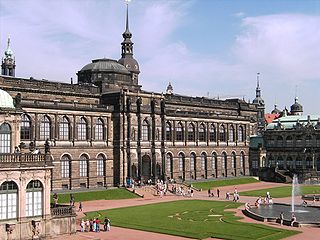
The Gemäldegalerie Alte Meister in Dresden, Germany, displays around 750 paintings from the 15th to the 18th centuries. It includes major Italian Renaissance works as well as Dutch and Flemish paintings. Outstanding works by German, French, and Spanish painters of the period are also among the gallery's attractions.

Ambras Castle is a Renaissance castle and palace located in the hills above Innsbruck, Austria. Ambras Castle is 632 metres (2,073 ft) above sea level. Considered one of the most popular tourist attractions of the Tyrol, Ambras Castle was built in the 16th century on the spot of an earlier 10th-century castle, which became the seat of power for the Counts of Andechs. The cultural and historical importance of the castle is closely connected with Archduke Ferdinand II (1529–1595) and served as his family's residence from 1567 to 1595. Ferdinand was one of history's most prominent collectors of art. The princely sovereign of Tyrol, son of Emperor Ferdinand I, ordered that the medieval fortress at Ambras be turned into a Renaissance castle as a gift for his wife Philippine Welser. The cultured humanist from the House of Habsburg accommodated his world-famous collections in a museum: the collections, still in the Lower Castle built specifically for that museum's purpose, make Ambras Castle one of the oldest museums in the world.

Hans Maler zu Schwaz (1480/1488–1526/1529) was a German painter born in Ulm and active as portraitist in the village of Schwaz, near Innsbruck. Maler may have trained with the German artist Bartholomäus Zeitblom, who was chief master of the School of Ulm between 1484 and 1517. He painted numerous portraits of members of the Habsburg court at Innsbruck as well as of wealthy merchants such as the Fuggers.
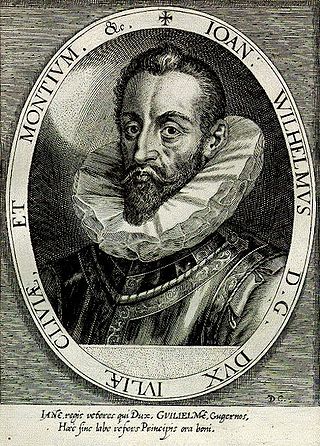
Dominicus Custos (1560–1612) was a Flemish artist, printer and copperplate engraver, who worked in the service of Emperor Rudolph II in Prague.

Lorenz Helmschmied or "Helmschmid" was a German armourer and a member of the Helmschmied family of armourers from Augsburg. He was one of the primary armourers to the Habsburg court of the Holy Roman Emperors Frederick III and Maximilian I, and created some of the most technically innovative and artistically complex armours of the late-fifteenth and early-sixteenth centuries.

Giuseppe Arcimboldo, also spelled Arcimboldi, was an Italian painter best known for creating imaginative portrait heads made entirely of objects such as fruits, vegetables, flowers, fish and books.

The Portrait of Sigismund of Luxembourg is a tempera on panel painting attributed to the Italian Late-Gothic master Pisanello and probably executed between 1432 and 1433. It is on display at the Kunsthistorisches Museum in Vienna, Austria.
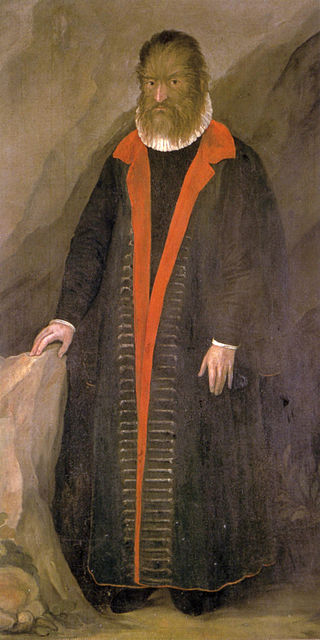
Petrus Gonsalvus, referred to by Ulisse Aldrovandi as "the man of the woods", was a gentleman in the court of Henry II of France. He was noted for having hypertrichosis, which led to him being known as the "wild gentleman of Tenerife" and the "Canarian werewolf". His life at various courts in Italy and France has been well chronicled.
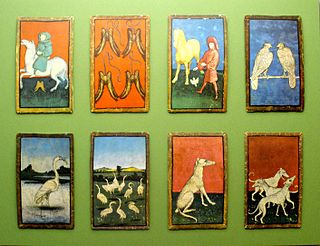
The Ambraser Hofjagdspiel, also called the "Ambras falconer cards", is a pack of cards painted around 1440–1445 and attributed to the engraver Konrad Witz from Basle, Switzerland. It originally consisted of fifty-six cards from which only 54 survive, all distributed in four suits, falcons, lures, hounds and herons, symbols related to hunting. Each suit contained ten pip cards with the 10s being represented by a banner like many old German playing cards and modern Swiss playing cards. There are four face cards per suit: the Unter, Ober, Queen, and King. It was found in a collection at the Ambras Castle, in Innsbruck, Austria, in the sixteenth century, and now figures as a precious item in the collection of cards of the Kunsthistorisches Museum in Vienna.
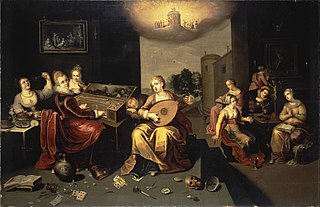
Hieronymus Francken the Younger or Hieronymus II was a Flemish painter and one of the most prominent members of the large Francken family of artists. Along with his brother Frans Francken II he played an important role in the development of new genres in Flemish art in the early 17th century. He was a prolific artist with a wide range who painted religious scenes, allegorical subjects, portraits, fruit pieces, genre scenes, architectural paintings and art galleries.
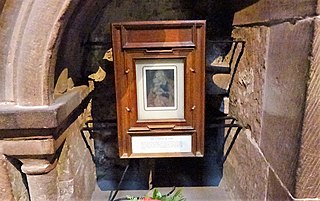
Cobweb painting, sometimes known as gossamer painting, is the delicate process of painting on canvases made from caterpillar and spider webs that have been collected, layered, cleaned, and framed. Fewer than 100 cobweb paintings are known to exist, many of which are housed in private collections.

Isabella in Red is a portrait of a woman by Peter Paul Rubens in the Kunsthistorisches Museum in Vienna. It is considered a close copy of a lost Titian original.

Ambras sketchbook (c.1410) is a rare set of 56 small-format drawings on 14 wooden plates that has survived in its entirety. It was in the collections of the Ferdinand II, Archduke of Austria at Ambras Castle and hence its designation in the literature. This work comes from the Prague artistic community and represents a sampling of faces from different phases of the development of the beautiful style, for which the panel paintings of Master of the Třeboň Altarpiece or the sculptural works of Master of the Týn Calvary and his workshop were a model. The sketchbook is also related to the typology of faces of the so-called Capuchin Cycle. Ambras sketchbook is in the collection of the Kunsthistorisches Museum in Vienna.



























